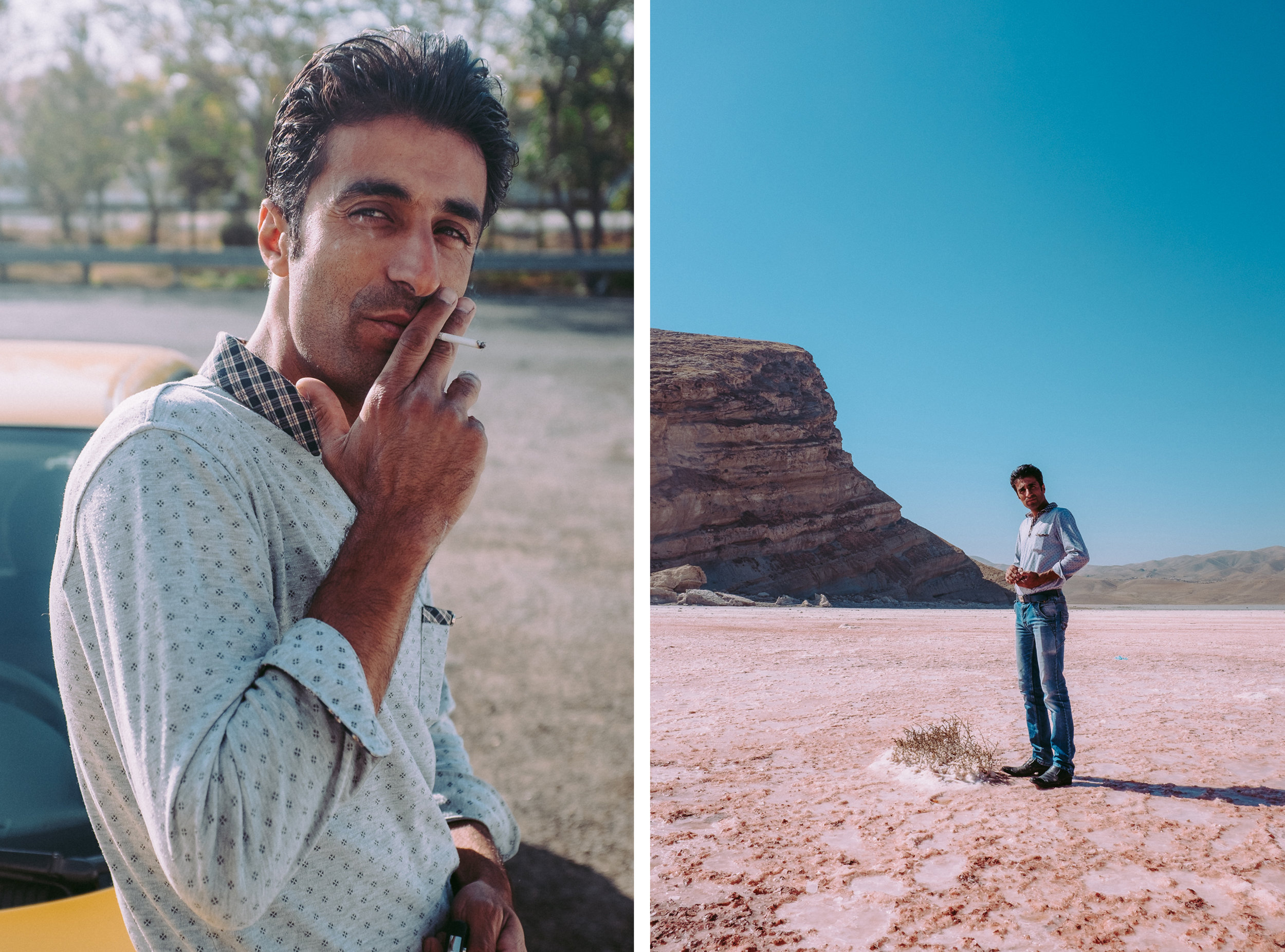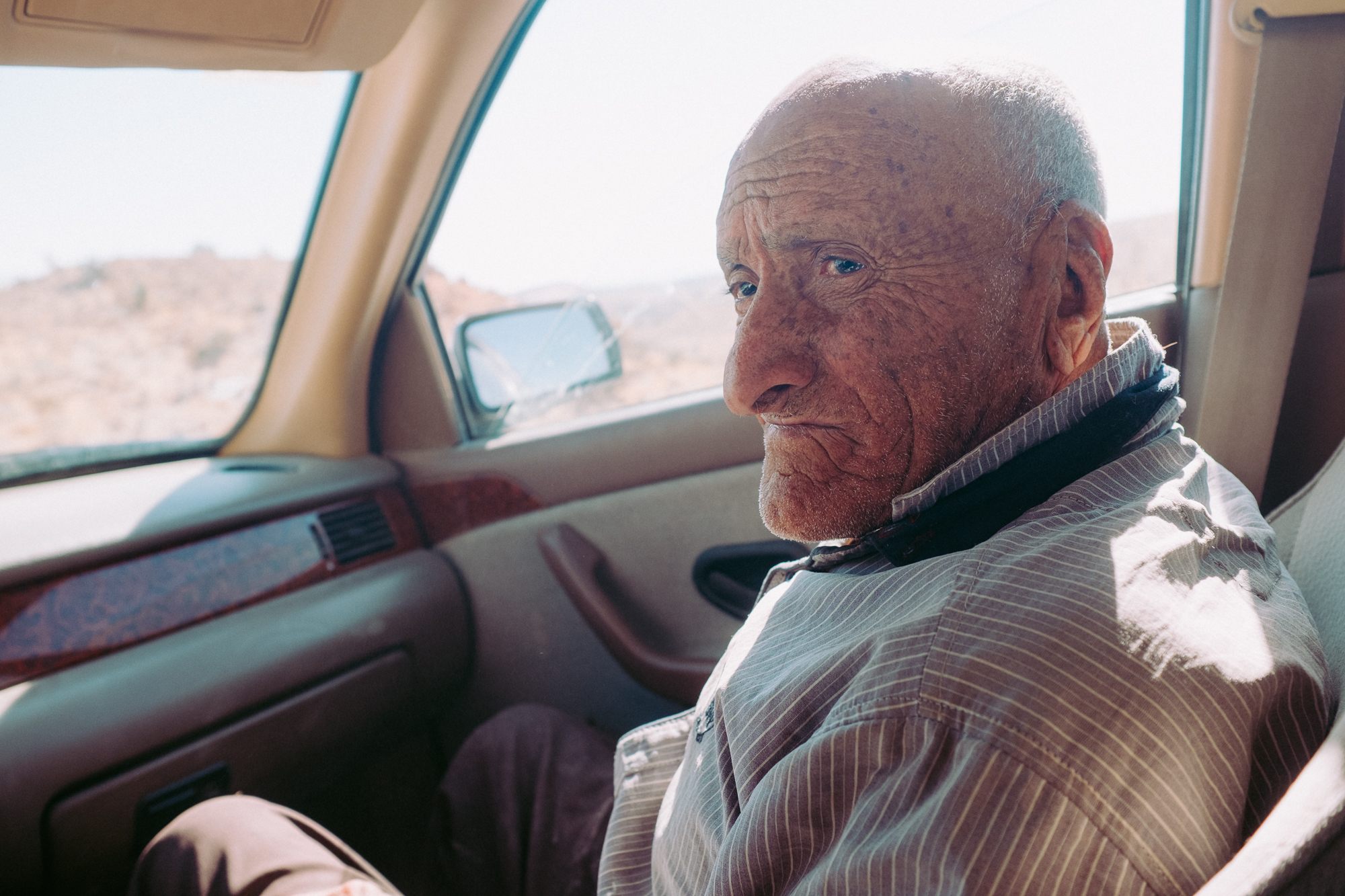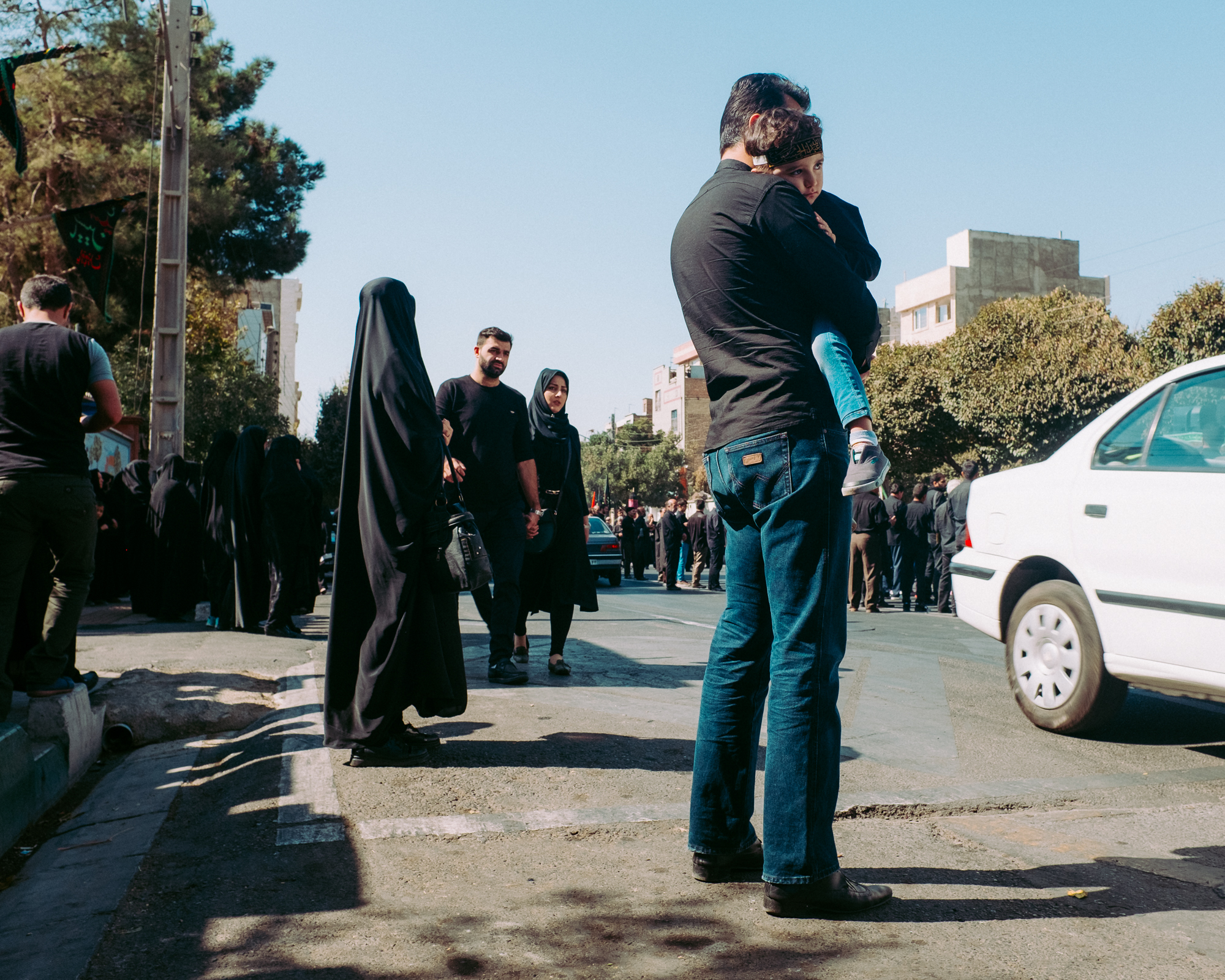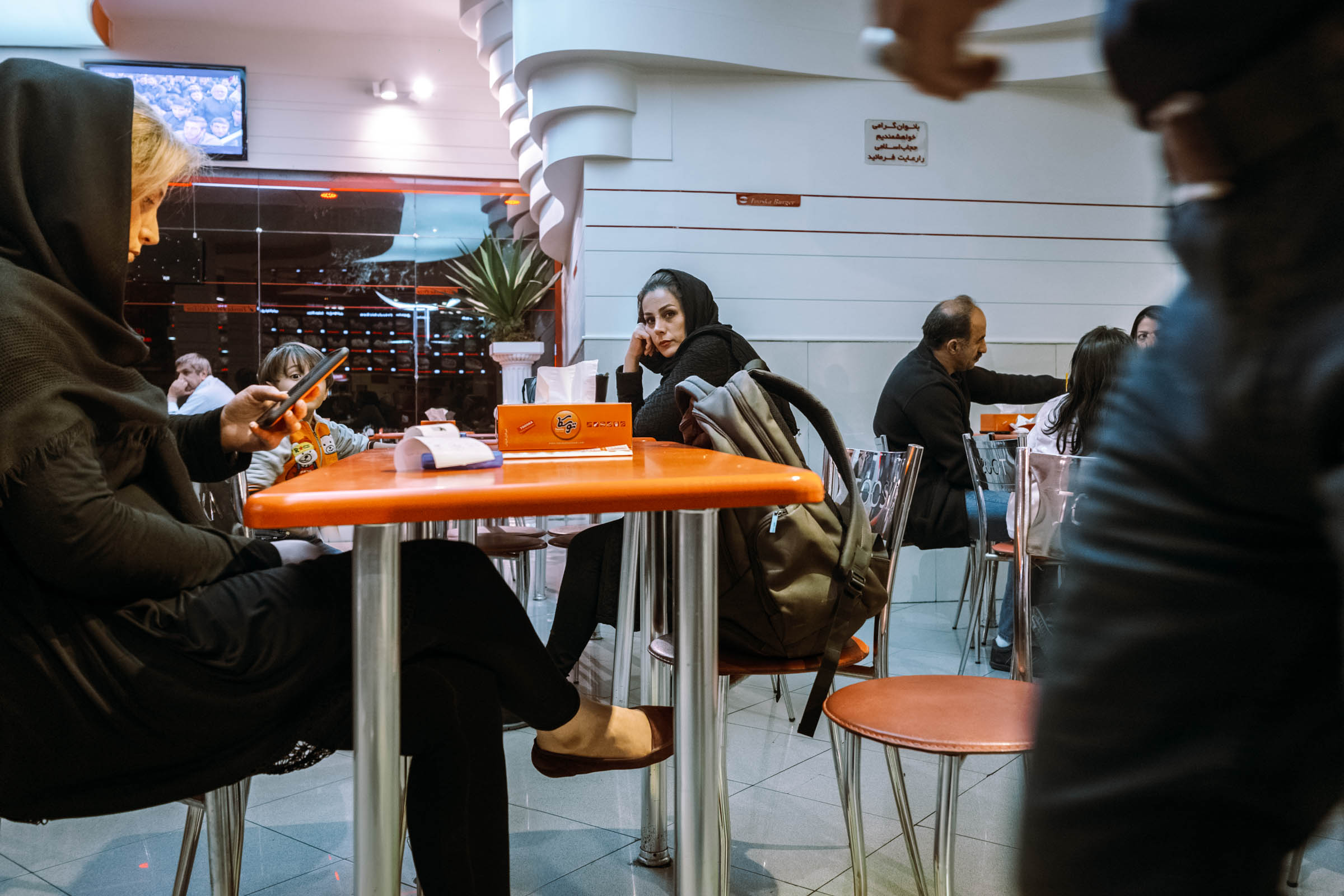

The ceiling design of the Ali Qapu music hall mesmerises locals and tourists alike. The bizarre planes and niches create an acoustic environment that enhances the sound of intimate Persian ballads, infusing them with a warm and sublime reverberation. In later years, women were no longer allowed in the room because of the male musicians. But due to the acoustic design of the palace, the wives and concubines could still enjoy the music carried through the many palace chambers.

Vacationers from nearby Tabriz used to pack Lake Urmia's banks. Once the tourists stopped coming, operators had no choice but to pack up and leave. Various artefacts and decaying foodstands now dot its banks, a haunting reminder of days gone by.

Previously one of the largest salt water lakes in the Middle East, Lake Urmia is drying up. Experts claim that poor agricultural planning, as well as short sighted dam construction efforts around the region are to blame. The pristine blue waters in many an Iranian vacation photo have in recent years turned blood red. Pictured here is a tiny islet of crystallised salt in a bed of shallow water, salt-loving bacteria and algae give the lake its current colour.

Farhad Asgari, right back of Tabriz's state football club and Tabriz city's most handsome taxi driver. We spent around 10 hours together that day. Even though we couldn't speak the same language, we somehow managed to hit it off. When it came time to part ways, he refused to take our money. It was exasperating. After a lot of evading, he finally said to us: "Friend no take money from friend." Farhad drove over 700 kilometres that day.

The hall of a hundred columns was constructed sometime in the 5th century BC by the Achaemenid king Xerxes. Archeological evidence points to the building being used to receive diplomats and foreign guests. More than two thousand years later, it continues to do the same.

Advertisers, in search of a visual shorthand to localise international brands, like to reach for images of Persepolis. Even if it seems incongruent, it gets the message across. And besides, it's royalty free.

With several hundred animals and just a few hands to herd them, moving house for the Qashqai nomads is never easy. For weeks they would cross highways, mountains and rivers, covering many hundred kilometres on foot, only to do it all again at the turn of the season. Keeping swarms of livestock hydrated throughout the journey is no easy task. Even though knowledge of available water sources has been passed down for generations, it doesn't apply anymore - the old rivers and creeks are drying up due to climate change and urbanisation efforts. The modern Qashqai needs to find his own way home.

A few dozen metres from the Ardekan- Shiraz Expressway, a mother sheep gives birth.

From Qashqai shepard boy to one of Shiraz's most successful travel guides, Bahman Mardanloo (pictured far right) has come a long way. At 12 he was sent away to the city to study and was the first of the 3 Mardanloo children to leave their nomadic family home in the Zagros. He visits home often, bringing back much needed news and entertainment from the city in the form of videos and jokes that he packs into his Sony Xperia.

As we were walking down the mountain behind the Mardanloo family's new campsite, Ali calls out to Bahman from the distance. Leaving his goats behind, he scampers up the steep hill to greet him. After a quick exchange, Bahman whipped out his Sony Xperia and started reading paragraph after paragraph off of his phone - this got Ali rolling in fits of laughter.

As we said goodbye to Ali we asked Bahman what that was all about. "I tell him joke." Seeing the confusion on our faces he continued to explain ,"Nomad people don't have Internet, or television or radio. So when I come back I'm like their internet, television and radio."

Preshkaft Village, also known by locals around the area as "Stone Village", is hidden in a valley about 7 kilometres off an unmarked Shiraz-Qaemyeh Highway exit. In the morning an elderly woman spotted through a hole in her kitchen roof and through Bahman, asked us which village we were from. "Singapore!" We said. To which she replied, "I've never heard of that village, is it very far from here?"
The elderly gentleman pictured here had been waiting hours by the main village road, hoping to hitch a ride to Shiraz. "My wife is dead and I live alone here. Sometimes my son invites me to the city to visit him."

Ashura commemorates the gruesome death and martyrdom of Hossein bin Ali, a descendant of the prophet Mohamed. Unlike the bloody displays that are shown in western media, the Ashura we experienced was a family affair. It was a time for charity work and family gatherings. In the day, families visit and watch the processions together and kids get to stay up for as long as they can.

In most Shia Muslim countries, self-flagellation is either frowned upon or banned completely. Not wanting to propagate the image of the fanatical Shia Muslim, some communities opt to conduct blood drives instead. In Iran, the majority use a light weight bundle of chains instead of the knives and whips of old.
To watch with sound, double click the video.

Although western dress is not frowned upon in Iran like in some parts of the region, there is prejudice against the suit-wearing Iranian man who doesn't keep a beard.

Western fast food is experiencing a boom in the major cities of Iran now. With little alternatives to traditional Iranian food, the advent of greasy fries and processed burgers is a welcome change. But variety doesn't come cheap. A meal in Tooska costs the same as dinner at a high-end Persian restaurant.

Western fast food is experiencing a boom in the major cities of Iran now. With little alternatives to traditional Iranian food, the advent of greasy fries and processed burgers is a welcome change. But variety doesn't come cheap. A meal in Tooska costs the same as dinner at a high-end Persian restaurant.


The Zoroastrian faith has roots dating back to almost two thousand years before the birth of Christ. Recognised as one of the four Abrahamic faiths (Zoroastrianism, Judaism, Christianity, Islam) they are entitled to special representation in the Iranian Parliament which is predominently Shia' Muslim.

Historically, the towers are usually built on top of hills, far away from populated areas. But as the city of Yazd expanded over the centuries, it has come to envelop these two towers. In modern times, Zoroastrians have stopped the practice of air burials, opting to cremate their dead instead. When I asked our guide Moshtaba why this is so, he said (in his typical deadpan fashion), "There were no more birds."

Hengameh (out of frame on the left) like many young Iranians, dreams of one day migrating to Canada. Being born into a Muslim family, her relationship with Mashhad, a Zoroastrian, has caused a rift between her and her parents. As a couple, they rebel against almost every Iranian social convention out there: a mixed couple, living together out of wedlock with a pet dog in tow. Hengameh explains, "Anytime they want, the police can take Momo and kill her on the road and we cannot do anything about it." Strict as the law may be, there are still many dog owners in north Tehran. A black market for dog food and toys supply couples like Hengameh and Mashhad with what they need to keep Momo happy and comfortable.

Many middle-class Tehranis dream of someday migrating to Canada. An Iranian TV station in Canada creates content specifically for viewers back in Iran, whose only way of accessing it is via a black market set top box. The reality TV show pictured here shows the reactions of everyday Canadian-Iranian families as they watch state-controlled TV programs from back home.
I asked Hengameh, "Wait, so you buy an illegal box, to watch Iranians in Canada watch shows in Iran." She laughs and says,"I know, crazy right? It's super popular here!"


























The ceiling design of the Ali Qapu music hall mesmerises locals and tourists alike. The bizarre planes and niches create an acoustic environment that enhances the sound of intimate Persian ballads, infusing them with a warm and sublime reverberation. In later years, women were no longer allowed in the room because of the male musicians. But due to the acoustic design of the palace, the wives and concubines could still enjoy the music carried through the many palace chambers.
Vacationers from nearby Tabriz used to pack Lake Urmia's banks. Once the tourists stopped coming, operators had no choice but to pack up and leave. Various artefacts and decaying foodstands now dot its banks, a haunting reminder of days gone by.
Previously one of the largest salt water lakes in the Middle East, Lake Urmia is drying up. Experts claim that poor agricultural planning, as well as short sighted dam construction efforts around the region are to blame. The pristine blue waters in many an Iranian vacation photo have in recent years turned blood red. Pictured here is a tiny islet of crystallised salt in a bed of shallow water, salt-loving bacteria and algae give the lake its current colour.
Farhad Asgari, right back of Tabriz's state football club and Tabriz city's most handsome taxi driver. We spent around 10 hours together that day. Even though we couldn't speak the same language, we somehow managed to hit it off. When it came time to part ways, he refused to take our money. It was exasperating. After a lot of evading, he finally said to us: "Friend no take money from friend." Farhad drove over 700 kilometres that day.
The hall of a hundred columns was constructed sometime in the 5th century BC by the Achaemenid king Xerxes. Archeological evidence points to the building being used to receive diplomats and foreign guests. More than two thousand years later, it continues to do the same.
Advertisers, in search of a visual shorthand to localise international brands, like to reach for images of Persepolis. Even if it seems incongruent, it gets the message across. And besides, it's royalty free.
With several hundred animals and just a few hands to herd them, moving house for the Qashqai nomads is never easy. For weeks they would cross highways, mountains and rivers, covering many hundred kilometres on foot, only to do it all again at the turn of the season. Keeping swarms of livestock hydrated throughout the journey is no easy task. Even though knowledge of available water sources has been passed down for generations, it doesn't apply anymore - the old rivers and creeks are drying up due to climate change and urbanisation efforts. The modern Qashqai needs to find his own way home.
A few dozen metres from the Ardekan- Shiraz Expressway, a mother sheep gives birth.
From Qashqai shepard boy to one of Shiraz's most successful travel guides, Bahman Mardanloo (pictured far right) has come a long way. At 12 he was sent away to the city to study and was the first of the 3 Mardanloo children to leave their nomadic family home in the Zagros. He visits home often, bringing back much needed news and entertainment from the city in the form of videos and jokes that he packs into his Sony Xperia.
As we were walking down the mountain behind the Mardanloo family's new campsite, Ali calls out to Bahman from the distance. Leaving his goats behind, he scampers up the steep hill to greet him. After a quick exchange, Bahman whipped out his Sony Xperia and started reading paragraph after paragraph off of his phone - this got Ali rolling in fits of laughter.
As we said goodbye to Ali we asked Bahman what that was all about. "I tell him joke." Seeing the confusion on our faces he continued to explain ,"Nomad people don't have Internet, or television or radio. So when I come back I'm like their internet, television and radio."
Preshkaft Village, also known by locals around the area as "Stone Village", is hidden in a valley about 7 kilometres off an unmarked Shiraz-Qaemyeh Highway exit. In the morning an elderly woman spotted through a hole in her kitchen roof and through Bahman, asked us which village we were from. "Singapore!" We said. To which she replied, "I've never heard of that village, is it very far from here?"
The elderly gentleman pictured here had been waiting hours by the main village road, hoping to hitch a ride to Shiraz. "My wife is dead and I live alone here. Sometimes my son invites me to the city to visit him."
Ashura commemorates the gruesome death and martyrdom of Hossein bin Ali, a descendant of the prophet Mohamed. Unlike the bloody displays that are shown in western media, the Ashura we experienced was a family affair. It was a time for charity work and family gatherings. In the day, families visit and watch the processions together and kids get to stay up for as long as they can.
In most Shia Muslim countries, self-flagellation is either frowned upon or banned completely. Not wanting to propagate the image of the fanatical Shia Muslim, some communities opt to conduct blood drives instead. In Iran, the majority use a light weight bundle of chains instead of the knives and whips of old.
To watch with sound, double click the video.
Although western dress is not frowned upon in Iran like in some parts of the region, there is prejudice against the suit-wearing Iranian man who doesn't keep a beard.
Western fast food is experiencing a boom in the major cities of Iran now. With little alternatives to traditional Iranian food, the advent of greasy fries and processed burgers is a welcome change. But variety doesn't come cheap. A meal in Tooska costs the same as dinner at a high-end Persian restaurant.
Western fast food is experiencing a boom in the major cities of Iran now. With little alternatives to traditional Iranian food, the advent of greasy fries and processed burgers is a welcome change. But variety doesn't come cheap. A meal in Tooska costs the same as dinner at a high-end Persian restaurant.
The Zoroastrian faith has roots dating back to almost two thousand years before the birth of Christ. Recognised as one of the four Abrahamic faiths (Zoroastrianism, Judaism, Christianity, Islam) they are entitled to special representation in the Iranian Parliament which is predominently Shia' Muslim.
Historically, the towers are usually built on top of hills, far away from populated areas. But as the city of Yazd expanded over the centuries, it has come to envelop these two towers. In modern times, Zoroastrians have stopped the practice of air burials, opting to cremate their dead instead. When I asked our guide Moshtaba why this is so, he said (in his typical deadpan fashion), "There were no more birds."
Hengameh (out of frame on the left) like many young Iranians, dreams of one day migrating to Canada. Being born into a Muslim family, her relationship with Mashhad, a Zoroastrian, has caused a rift between her and her parents. As a couple, they rebel against almost every Iranian social convention out there: a mixed couple, living together out of wedlock with a pet dog in tow. Hengameh explains, "Anytime they want, the police can take Momo and kill her on the road and we cannot do anything about it." Strict as the law may be, there are still many dog owners in north Tehran. A black market for dog food and toys supply couples like Hengameh and Mashhad with what they need to keep Momo happy and comfortable.
Many middle-class Tehranis dream of someday migrating to Canada. An Iranian TV station in Canada creates content specifically for viewers back in Iran, whose only way of accessing it is via a black market set top box. The reality TV show pictured here shows the reactions of everyday Canadian-Iranian families as they watch state-controlled TV programs from back home.
I asked Hengameh, "Wait, so you buy an illegal box, to watch Iranians in Canada watch shows in Iran." She laughs and says,"I know, crazy right? It's super popular here!"